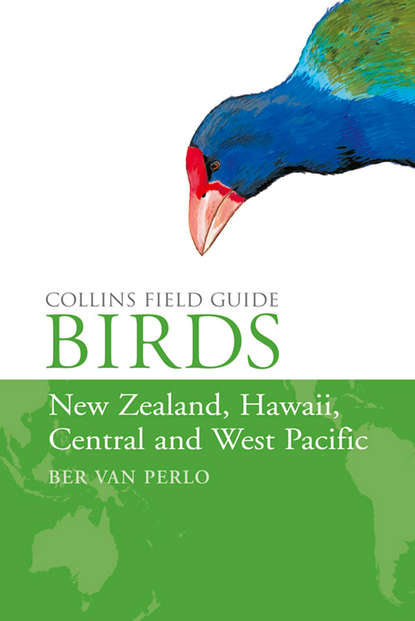По всем вопросам обращайтесь на: info@litportal.ru
(©) 2003-2024.
✖
Birds of New Zealand, Hawaii, Central and West Pacific
Настройки чтения
Размер шрифта
Высота строк
Поля
Riverine belt Any growth along a river or stream that is higher and greener than the more distant surroundings.
Rufescent Tinged with red-rufous colour.
Savanna In this book: any (large) area with a continuous cover of (high) grasses, interrupted by shrub and (5–30%) tree canopy.
Second growth New natural forest developing in places where the original forest has disappeared.
Speculum Patch of colour on the wing contrasting with that of the rest of the wing.
Transient plumage Stage between Br and N-br plumages with traces of Br plumage still visable.
Woodland A habitat in which trees dominate, but the canopy is not closed.
Parts of a Bird
Introduction
Systematics and Names
In order to apply a uniform systematic approach and set of names that are valid in New Zealand, Hawaii, the USA, Asia, Europe and anywhere else, this book follows James F. Clements The Clements Checklist of the Birds of the World, 6th Edition (Helm, 2007) with regard to systematic status (species or subspecies) and names (scientific and English).
However, the best-known or most widely used common names used by New Zealanders and in Hawaii should not be neglected, if only to make it easier to find the birds of this book in regional publications. Therefore, alternative English names for species, advised by the Ornithological Society of New Zealand (OSNZ) for New Zealand and by the American Ornithological Union (AOU) for Hawaii, are indicated as insertions in the ‘Clements name’, preceded by ‘NZ’ or ‘AOU’ in superscript. For example:
the species indicated by number 20.9 (Plate 20, number 9) in this book is named the ‘INTERMEDIATE (or
Plumed) EGRET’; the ‘Clements name’ is INTERMEDIATE EGRET, while the ‘OSNZ name’ is PLUMED EGRET;
number 28.1 in this book is named the ‘(
Australian) WHITE-EYED DUCK’; the ‘Clements name’ is WHITE-EYED DUCK and the ‘OSNZ name’ is AUSTRALIAN WHITE-EYED DUCK.
In a few cases, well-known alternative names are inserted in the ‘Clements names’, such as:
41.5 SNOWY (or Kentish) PLOVER
There are also many local names for subspecies, mentioned by the OSNZ and in use for those that occur in New Zealand; these names are given in numbered notes following the captions. An example is:
38.5 PURPLE SWAMPHEN44 Porphyrio porphyrio
ssp melanotus
Pukeko;
ssp pelewensis [Palau]
ssp samoensis [Samoa and Fiji]
In this example, the subspecies Pukeko occurs solely and exclusively in New Zealand (with the extra complication that it is treated by the OSNZ as Nominate of SOUTH-WEST PACIFIC SWAMPHEN
Porphyrio melanotus). In the following example there are four subspecies found in New Zealand:
14.8 LITTLE SHEARWATER19 Puffinus assimilis
Nom.
Norfolk Island Little Shearwater
ssp kermadecensis
Kermadec Little Shearwater
ssp haurakensis
North Island Little Shearwater
ssp elegans
Subantarctic Little Shearwater
Of these, elegans can also be seen outside the area covered by this book, but only in NZ it is known as Subantarctic Little Shearwater. (Note: The OSNZ has recently risen the Clements subspecies elegans to independent species
SUBANTARCTIC LITTLE SHEARWATER Puffinus elegans.)
The French names are those of the Commission Internationale des noms français d’oiseaux (CINFO 1993).
The sequence of families in this book is more or less traditional, but strongly adapted in order to include up to a maximum of nine, rarely ten similar-looking species, sometimes from different families, in one plate.
Format of the Species Accounts
Plates
In general, the plumages depicted on the plates are Br. plumages unless otherwise indicated. Normally, the birds on any given plate are painted to the same scale except flight silhouettes, which are normally shown smaller. If
and
have different visual features, such as colouring or dimensions of body parts (e.g. tail length), both are illustrated, unless the differences are only small (e.g. a slightly duller colour of the
). Juveniles, immatures and/or first winter plumages are shown when they are often seen in these plumages. N-br plumages are given if the birds visit the area in this plumage; migrants such as waders, which are mainly seen in N-br plumage, are illustrated in this plumage on the plates. If several subspecies of a species occur in the area, and they are distinguishable, these are in many but not all cases illustrated, but not for example, those separable mainly on basis of range.
An effort has been made to show the birds in their typical ‘jizz’; what birders call jizz is a difficult to define combination of size, relative proportions and body carriage of a bird. Part of a bird’s jizz can be, for example, its stance (the angle of its body axis to the horizontal).
Captions
The information for each species is given in this order:
• the English name in bold capitals (with alternative names in standard lower case);
• the French name between square brackets;





